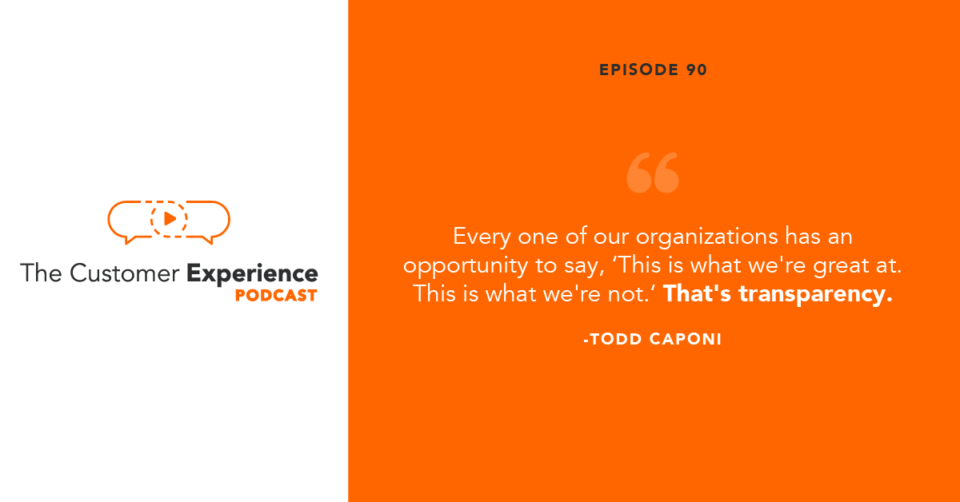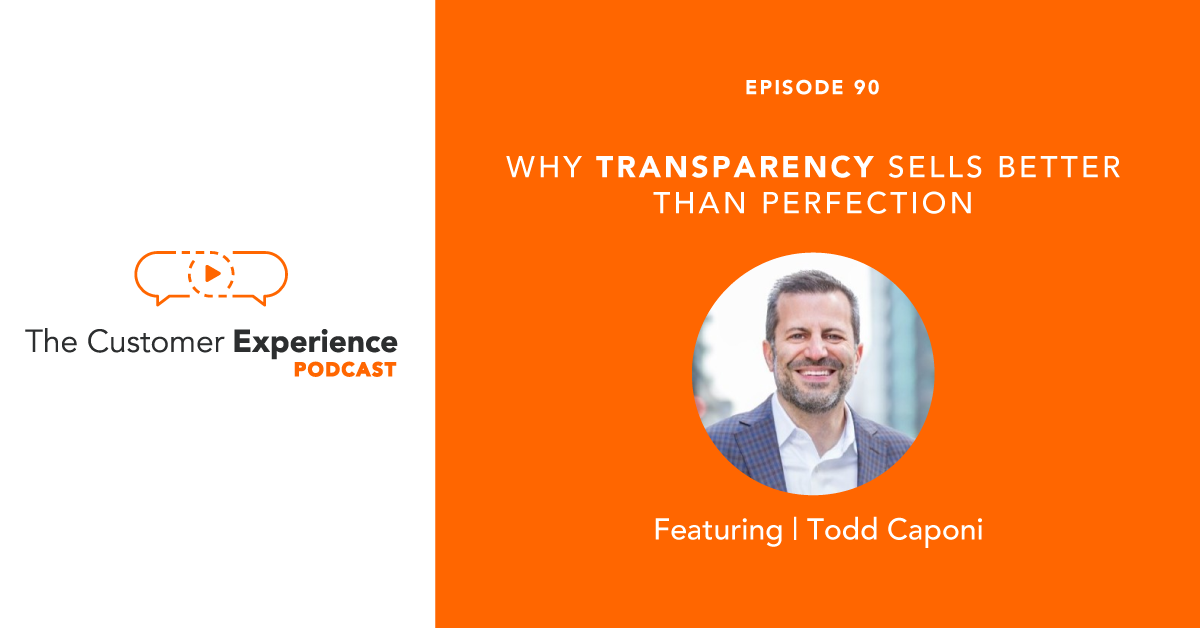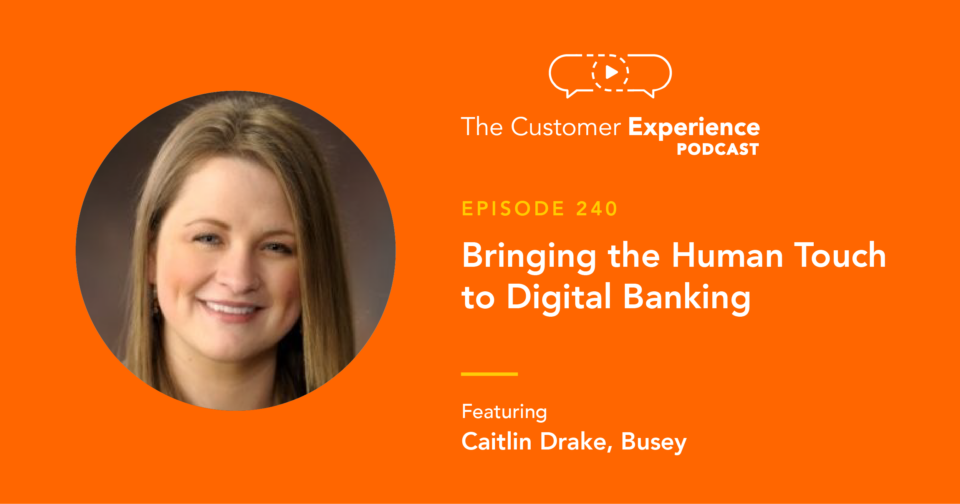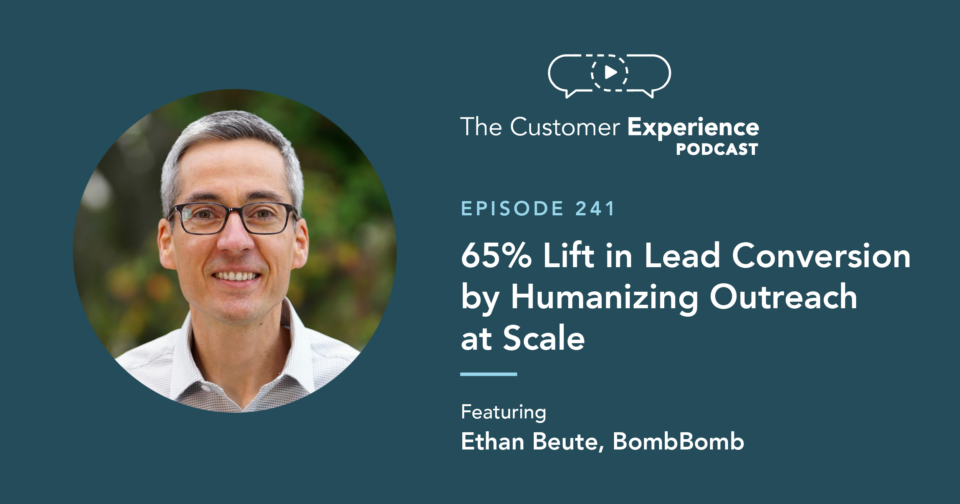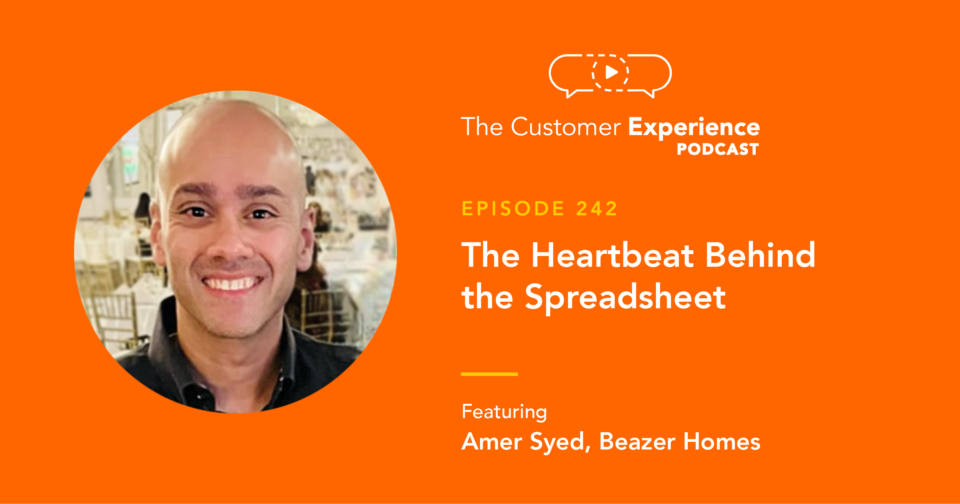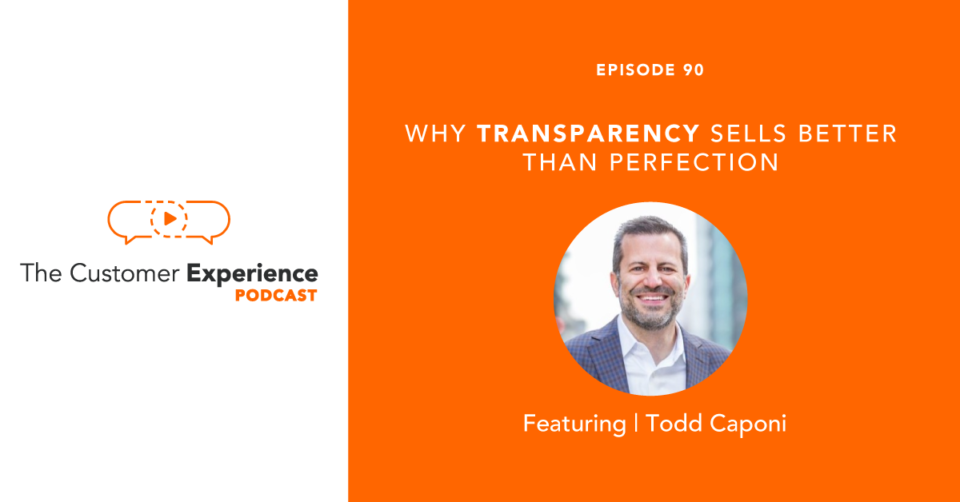
Listen to “90. Why Transparency Sells Better Than Perfection w/ Todd Caponi” on Spreaker.
Apple Podcasts | Google Podcasts | Stitcher | Spotify
About 96% of consumers look at reviews. Why? Because they’re trying to predict what the buying experience, user experience, renewal experience, and everything in between, will be like. They want to know what to expect before going into business with you.
The last thing they want is for an organization to overpromise and underdeliver. They hope that your product or service promises to match the delivery. In other words — they long for transparency.
Today’s guest on The Customer Experience Podcast, Todd Caponi, landed one of the best and fastest deals of his life by being transparent and explaining what his competition did better. He was more focused on helping his prospect know exactly what to expect (pros and cons) than making his product appear bigger or better than reality.
When he kept applying this philosophy, he kept making big sales. So he wrote a book about it.
Todd is the Founder at Sales Melon, author of The Transparency Sale, and former CRO at PowerReviews. His insight on how personalization with video helps you break through the white noise to achieve legit engagement reminds us that transparency, not perfection, should be our objective.
In this episode, Todd explains things like …
• What the differences are between transparency and authenticity
• How opening on a competitor’s strengths worked for Todd
• How personalization and value help your communication stand out
• Why not to present your products as perfect
• Why presenting contracts with a letter or video is beneficial
Why Transparency Sells Better Than Perfection
Hear the entire conversation with Todd Caponi, author of The Transparency Sale, right here:
Listen to “90. Why Transparency Sells Better Than Perfection w/ Todd Caponi” on Spreaker.
Hear this episode of The Customer Experience Podcast – and many others – by subscribing to in:
Click one of the links above. And while you’re there, please subscribe – and consider adding a rating or review. Just a minute of your time is very helpful to the show.
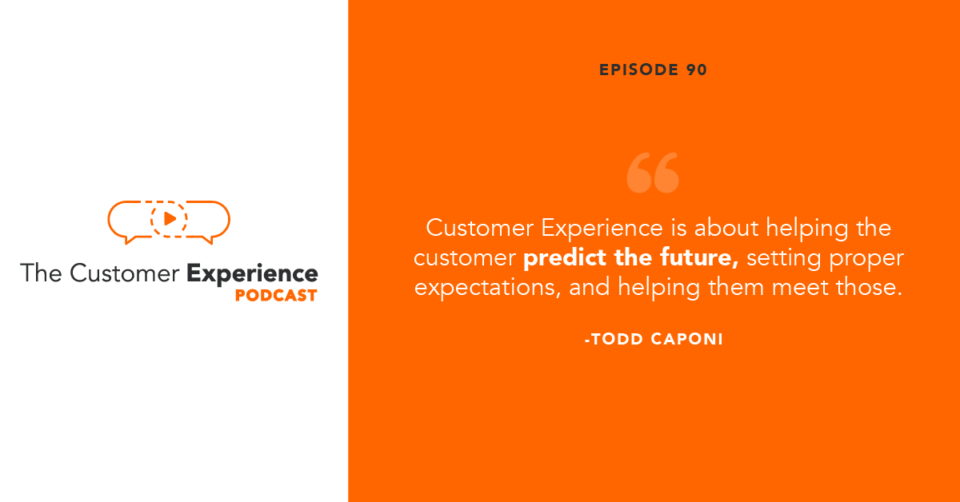
Full Transcript: Why Transparency Sells Better Than Perfection
Ethan Beute:
Transparency sells better than perfection, so the future of sales is radically transparent. The goal then isn’t 5 stars or the veneer of having a 5-star product or service, instead, our approach must be honest and trustworthy, something more like a 4.2 to a 4.5-star rating. These are astute observations of today’s guest who operates at the intersection of sales and science. He’s both a student and teacher of subjects like human behavior, human decision-making, and learning theory. He served in a variety of sales leadership roles with exact target in Salesforce Marketing Cloud.
Ethan Beute:
A couple of years ago, he left his role as Chief Revenue Officer of Chicago’s fastest-growing tech company, PowerReviews, to write a best-selling and award-winning book, The Transparency Sale. That’s what we’ll be talking about today. Today, he writes, speaks, advises and consults for a variety of clients, including LinkedIn, Lessonly, Showpad, LeanData, Zendesk, and more. Todd Caponi, welcome to The Customer Experience Podcast.
Todd Caponi:
Thank you for having me. I’m excited about this one.
Ethan Beute:
Yeah, me too. I feel like just in the way that we think and see things, there’s going to be a lot of kinship here. So, much of what you’re talking about, because The Transparency Sale covers the entire customer lifecycle from prospecting and email tips, which we may get into, through the handoff and through post-sale. So, it really is end to end. I think a lot of that probably comes from your experience as a CRO, responsible for the revenue outcomes across that lifecycle. But before we jump into it, tell me a little bit about your zoom background. It’s pretty interesting. For folks who are listening, we put video clips on LinkedIn. We put video clips in the blog post which you can visit at bombbomb.com/podcast, but I think this is going to be pretty interesting even to the listeners.
Todd Caponi:
Yeah, I’m a nerd for sales methodology, sales philosophy, and then behavioral science. All of a sudden, I don’t know where it came from, but I’ve established a new nerdery around sales history. If you go onto Google and you just search sales history, there’s some people that have done a pretty decent job of it, but I decided to go really deep. So, I have a book that is copyright 1947. It’s called The Five Great Rules of Salespeople, and it was written by Percy Whiting. I’ve literally read it four times. I have it all tapped up, but then it references books from the ’30s and then the ’20s. I find those, and they keep referencing back. So, I’ve been really digging into what sales was like in the late 1800s, early 1900s.
Todd Caponi:
So, for anybody who can see this, this is a picture of what’s called the drummer’s yarn. So, back in the 1800s, the majority of sales reps were called drummers. They’re essentially manufacturer reps. So, they would represent a number of manufacturers and bring their products to the different general stores, which I guess you’d call retailers. The drummer’s yarn was something… It was like a magazine that would come out that would help the drummers to tell funny stories and tell jokes because the original sales methodology from their perspective was that’s how you disarm is to tell a funny story, tell a joke or what they called tell a yarn.
Todd Caponi:
So, like this picture is of the drummer’s yarn, and you can see that the retailer is dying, laughing as the drummer is telling the joke. Everybody around on the train car is disgusted because the jokes are typically kind of gross, so.
Ethan Beute:
Nice. Off-color, classic. So, I’m going to assume that even if you’re just kind of early in this journey, that there are some truths that you may assume were fundamental, that have maybe proven out to be so. In your walk back through time of sales, obviously, the tech changes, the products changed. There are some nuances to all, but what are maybe one or two truths that became more apparent to you in this journey?
Todd Caponi:
Well, it’s funny because I’m on LinkedIn a lot. It’s amazing to me that if you go through the LinkedIn timeline, I would say 90+% of the tips that are given on LinkedIn, I have managed to find versions of from the 1920s and 1930s. There’s a magazine called Tractor World Magazine, but there’s a magazine for tractors, right? May of 1921 had an article about like the 10 qualities of a truly great salesperson. So, again, May 1921, so 99 years ago. If you had these as an organization as your 10 today, you wouldn’t be surprised by any of them.
Todd Caponi:
If you walked into a company as new salespeople, and they’re like, “Here’s our 10 truths of what it takes to be a great salesperson,” you go, “I agree with all of them.” It’s things like, know your products; don’t exaggerate; don’t ever knock your competitors; have a good appearance, like take pride in yourself every day. It’s things like that. So, that was kind of the fundamental one is now I read these LinkedIn posts and I’m like, “1936, that guy said that. 1926…” It’s amazing to me. So, there’s so much that was the same. Now, there’s also a couple of things back in the 1920s that would blow your mind about, like people actually believed this as a good sales methodology.
Todd Caponi:
One really quick one is the concept of phrenology. Phrenology, it was considered a pseudoscience back then. You’re analyzing a person’s structure of their skull and making assumptions about their willingness to take on new ideas versus being only feature benefit. It was actually a methodology that Ford Motor Company used in the 1920s. It was based on I’d read your forehead, and then I would make alterations to the way that I messaged my products based on the structure of your head. I was like, “Really?” Seriously, yeah, it’s amazing to me. So, there’s some things like that that are hilarious.
Ethan Beute:
I’m glad that for phrenology has gone the way of gross off-color jokes.
Todd Caponi:
Yes, exactly. That’s right. I mean, there was some other ones, back then there were books on the psychology of sales. So, today, we’re going like, “Gosh, we learned so much about behavioral science.” We really need to be taking that in the world of selling, but that’s exactly what they were doing 100 years ago, too. A lot of the psychology still holds true. Some of its kind of wacky. I mean, there was the chemists which are basically pharmacists back then felt that psychology was getting too much credit in the sales world and they wanted their take.
Todd Caponi:
So, there’s a book… It’s called What Salespeople Should Know About Their Health from the 1920s. It talks about what they referred to as your ductless glands. Your ductless glands are the difference between success and failure back then. That’s like your thyroid, for example. If your thyroids out of whack, doesn’t matter how good of a salesperson you are, you’re not going to have the energy, you’re not going to come across the way that you should. As a result, you’re going to fail. So, we need to pay attention to our ductless glands. So, much, I could go on all day on this, but it’s fascinating.
Ethan Beute:
It’s good. So, alright, so let’s get into it. Let’s talk customer experience to start. When I say that to you, Todd, what does it mean to you?
Todd Caponi:
Well, we as human beings are wired to try to predict what our experience is going to be. I mean, that’s what really informs our whole decision-making process. As you talked about reviews at the beginning, that’s why 96% of us look at reviews, we’re trying to predict what our experience is going to be like. So, when I think about customer experience from the first touch to, they’re staying, they’re buying more, and they’re advocating, that whole process, it’s about setting proper expectations and allowing the customer to predict their experience. When we do that and when they find that it matches, that’s basically the bottom of the line for what will cause them to stay, buy more, and advocate.
Todd Caponi:
So, customer experience to me, and I know thinking about it from my Chief Revenue Officer perspective, nothing like ruining customer experience by overpromising and underdelivering, right? But if you under-promise and you deliver at that level, you’ll still have a satisfied customer, right? So, it’s about helping the customer predict the future, setting proper expectations, and helping them meet those, that’s what drives the whole customer experience from my perspective.
Ethan Beute:
Love it. To my memory and if there are any people who’ve listened to as many episodes as I’ve produced, you might come up with another one, but it reminds me a little bit of Shep Hyken, who you may know.
Todd Caponi:
Yeah.
Ethan Beute:
We talked about being slightly better than average all of the time. That’s enough to just blow the doors off the competition’s, the same thing. Just don’t disappoint people. So, I really like your expectation management, I think it’s something that we think about from time to time, but I don’t know that we’re dedicated to it as much as we really should be and probably even probing it as much as we should be. I think there are a lot of feedback channels and you write about a number of them in The Transparency Sale, but I don’t know that we’re dedicated enough to establishing what the expectation was at one point relative to where the customer is now. It’s really interesting.
Ethan Beute:
So, another definitional question I would like to get to you before we get too deep into some of the more fun and interesting and detailed stuff that we can get into is transparent and transparency. Obviously, that word has kind of bubbled up in popular business culture as have words like authenticity or vulnerability, etc. What does transparency mean to you in particular? It’s obviously different than those other words, because those words exist differently for a reason, but kind of walk through a little bit of that territory to get folks cleared on the same page with you.
Todd Caponi:
Yeah, so, first of all, we’ve been talking a lot about transparency lately, and to my point earlier, Baltasar Gracián, Spanish philosopher, I think it was 1640s, talked about transparency and exaggeration back then. So, a lot of what’s new was old that is old too. So, it’s a great point. When I hear the word transparency and I hear the word authenticity, those are actually vastly different words. Authenticity is being your true self and bringing you and like, “Hey, this is me,” right? Transparency is about expectation setting, right? It’s about I got a chair right here if my customer was right there, is there anything that I would talk about internally to only my employees that I wouldn’t talk about to them about the products, about the solutions, about the technology?
Todd Caponi:
Transparency is about allowing the customer to predict what their experience is going to be by telling them what might not work in their environment and what might work. As sales professionals, as client success professionals, as account managers, our role is to aid the buyer in their journey to make the best decisions for them, right? Our job is to help guide them through that process. If we’re going to lose, lose fast. If you’re going to lose, you want to lose fast, the best way to do that is to embrace transparency, which is to say, “Mr./Mrs. Customer, here’s some of the things that we as an organization, give up to be great at our core.”
Todd Caponi:
One of the stories from the book you might remember is the IKEA, but it seems to be so relevant to people when they think about if you want to have a salesperson help you design your home like your living room and you’re going to want the furniture delivered, assembled, maybe Feng shui-ed or whatever it’s called, all that kind of stuff, guess where you’re not going? IKEA.
Ethan Beute:
IKEA.
Todd Caponi:
Right. IKEA, you’re going to find it yourself. There’s no salesperson around. So, you got to write down the code because you’re going to go to the warehouse. You’re going to pick the boxes, put them onto a cart that weighs the boxes that weigh a million pounds. Put it on the cart, doesn’t have brakes, jam it into your car, tests your style, drive home with an injury or two. Get home and think “Gosh, I hope I left all the crap at the IKEA.” You open the box. There’s 150 parts and no words on it. You swear your way through it.
Todd Caponi:
And then when it’s put together, you got a little endorphin rush like, “Gosh, that was great. Maybe I should have bought the end tables with that bedroom set. Let’s go back.” Right? That’s what transparency is. It’s saying we’re going to give up that experience, so we can be great at giving you modern Scandinavian design furniture you didn’t pay much for it. I think every one of our organizations, we have an opportunity to do that and say, “This is what we’re great at. This is what we’re not.” That’s transparency.
Ethan Beute:
Right. You welcome maybe the opportunity or you aid the person to say, “If this is what you’re looking for, something we’re not great at, something that we maybe got dinged up on a review because we didn’t manage that expectation well enough, they were expecting something didn’t deliver. You might like this competitor of ours or you might like this product or service alternative.”
Todd Caponi:
Exactly. It’s amazing how that disarms, build trust, speed sales cycles. The one story I talked about in the book was the first time I tried it. So, at PowerReviews, which is where all of this kind of gelled for me. The PowerReviews, they help retailers and brands collect and display ratings and reviews on their website. So, you’re on crocs.com or Vineyard Vines or Jet and you see the reviews next to a product, that was PowerReviews helping to do the collect and display. But the first time I tried this though, it was almost like it was meant to be that I was in New York. I thought I was having coffee with the head of e-commerce of a major apparel brand. But when I got to his office, the first thing he did was point to his monitor at his desk, and he’s like, “You can plug in your laptop for the presentation there.”
Todd Caponi:
And then I turned to my right and all of these people were coming in. It was nine of us in his little Manhattan office. I thought we’re having coffee. The guy starts with… It was New York in the best way possible and that there was no small talk. It was, “Todd, we’re looking at your competitors. We’re looking at you. How are you better?” Everybody’s all geared up like, “Okay, here comes the sales pitch.” I just stumbled upon all of this research and data, and I knew the science matched up. I was like, thinking to myself, “I’m going to try it.” So, I just did this-
Ethan Beute:
That’s a bold choice. It’s a bold choice in that moment, even though you know the science is behind you.
Todd Caponi:
Exactly, exactly. I was like, “I’m going to try it.” The good thing is, I was by myself too. I’ve never revealed this part, but if it gets screwed up, there’s nobody that I work with that can yell at me. So, why not? It was perfect. I appreciate the guy asking what how we’re better, but I said, “Hey, listen, our competitor that you just talked to, they just released something that we don’t have, we don’t do. So, can we start with that? Let’s start with something that they’re better than us at because if that’s going to be important, let’s get that out of the way. Maybe I saved your whole crew here an RFP writing and a whole dog and pony presentation.” They all looked at me like I was crazy, but you could feel them all just kind of go poof like the air comes out. They’re like, “Yeah, go ahead.”
Todd Caponi:
I was like, “Well, they just released an add-on. It’s not rating reviews, but it plugs in. Here’s what it does. The first customer is Gap, which is again, another apparel brand. Gap apparently loves it. So, they just released it. Not on our roadmap, we hadn’t even considered it. I’m not even sure we will, and here’s why.” All of a sudden, they’re basically going back and forth going, “Yeah, why would we go to a rating reviews technology company for that? If we didn’t want that, how would we get it?” I’m like, “I don’t know. They just came out with it yesterday.” It was like we’re all on the same team type conversation. It was truly transparent. Within 15 minutes, the conversation was over. He kicked everybody out of his office and literally showed me his budget, which I never had anybody do ever.
Todd Caponi:
Literally, every eCommerce spend, fifth line down ratings, and reviews, can you hit that top? They made their decision 10 days later in what normally would have been a six-month sales cycle. I was like, “All right, I got to write a book. This is crazy.” We kept trying it and it kept having similar results. I’m like, “Alright, there’s something to that.” But that’s what transparency is, is be their Sherpa. Tell them what the competitor does do better. If that helps them make a good decision, to that point about how I view what customer experience is, that’s it, that’s setting expectations.
Todd Caponi:
That’s saving the customer four months of writing an RFP and going through this whole process to only find out at the end. Well, tell them at the beginning. That’s what truly builds trust to and I believe that there’s still a great customer of power it is.
Ethan Beute:
So good. It tied together everything we’ve talked about so far, which includes this idea of dropping the veneer of perfection or a five-star review and just being honest about what you’re great at and what you’re not great at. It’s this idea of what would I share if the customer was in the room? Would I guard myself with me? Would I, along with to my team members, not say something if there was a customer in the room? Again, this true partnership, a long-term relationship, starting off in the best way possible, and the reciprocation that CEO had is just fantastic. Here’s my budget, right? It’s just this wonderful give and take, which tees up the subtitle of the book.
Ethan Beute:
Again, it’s The Transparency Sale, How Unexpected Honesty and Understanding the Buying Brain Can Transform Your Results. So, I feel like we’ve already done a nice drive by on unexpected honesty, right? It’s just so refreshing. I don’t know how long this window is going to last, where this level of honesty and openness and transparency will be refreshing, but we’re definitely in that window. So, let’s flip a little bit and talk about the buying brain. What are a few specific to kind of sales process or the customer lifecycle or kind of a CRO type seat or hat or mindset? What are a few things about the buying brain that as you really got into this over the past several years, were either A, the most impactful or B, the most surprising? Give us a couple of nuggets about the buying brain.
Todd Caponi:
Yeah, as I went through this, there’s so many not only learnings about the buying brain that seemed counterintuitive, especially in the way that you’d implement them in sales, but then there’s a couple of tactics that have worked for me that now I understand why from a brain science perspective. So, let’s start with the former, which is the kind of the counterintuitive brain science stuff. I think there’s a number of people that have come to this conclusion, because I’m seeing it more and more, but it’s this idea that we literally use the feeling and emotion center in the middle of our brain to make all of our decisions. We use logic to justify those decisions, right?
Todd Caponi:
The one story I tell that happened right out in my driveway, which was my neighbor. He was mid-40s, used to drive a Toyota Corolla around. And then all of a sudden, one day he pulls up, there’s a white Corvette with an orange racing stripe on both sides. So, I’m taking out the garbage. I go out there and I’m like, “Dude, where did this thing come from?”
Todd Caponi:
He was like, “Oh, Todd, here in Chicago,” which is where I live, “pulling onto the expressway, that Corolla, every time, I felt like Fred Flintstone. I wanted to get my feet under and give it an extra kick. So, I needed something that had really good pickup. So, I went to the dealer and they had 0% APR for 60 months.” I was like, “Gosh, it’s meant to be.” That’s not why you bought a white Corvette with orange racing stripes, right?
Todd Caponi:
Obviously, it’s feelings and emotion and he’s using logic to back it up. Now, that matters in two pieces. You know, number one is, as it turns out, logic is polarizing. You’ve heard about subconscious bias, those types of things. But when we’ve made a decision in our brain, so we’re leaning in one way or the other. When we hear logic, we use that logic to either reinforce our feeling or to create a counter-argument for that feeling. Logic rarely changes our minds.
Todd Caponi:
Why that matters to you in a sales perspective, in a client success perspective, you’re trying to do upsells, is that when we lead with logic, we lead with ROI, we lead with data, we lead with studies, we’re actually helping to reinforce the initial feeling the customer had. I’ll tell you a quick story there. As you can tell, I tell lots of stories. But one of the great examples of what I see salespeople doing wrong is leading with slides that are either, “Hey, here’s all the awards we’ve won.” The killer is the NASCAR slide. Now NASCAR slide, meaning your slide that has all your customer logos on it.
Ethan Beute:
These are 174 most familiar logos that one time were customers of ours.
Todd Caponi:
Right, and we’re so proud of it, right? That’s why we put it out there at the beginning, just like, “Hey, look at us, aren’t we great? We’ve got all these great customers.” Well, if you picture, you’re doing a consensus sale. So, you’ve got 10 people in the room or on Zoom or whatever, and you’re doing this presentation and you start with that. Here’s what happens, five of them have walked in and they’re on your side. They’re just like, “Ethan, I’m leaning towards you, buddy.” You show that NASCAR slide, those five people are going to go “Wow, if Ethan’s good enough for those companies, they’re good enough for us. I’m going to use that to justify the purchase.”
Todd Caponi:
But what about the other five that are either leaning towards a competitor or leaning towards not doing anything at all? They’re looking at that same exact slide that you’re so proud of and using it against you. A couple of them are looking at it going, “Gosh, how many customers is this dude have? We’re going to be lost in this. We’re going to be a small fish in a big pond. Some of those are big companies. We’re not that big.” A couple others might be looking at it and going, “Gosh, apparently Ethan’s a generalist. He works across all verticals. Apparently, he doesn’t know us. He’s working CPG and a pharma and like all these. It sounds to me we need somebody who’s going to be more of a specialist.” So, they just use your logo slide to make the decision not to go with you. So, that’s a big piece.
Todd Caponi:
Logic is polarizing. How we flip that is through stories. I’ve got a whole pile of books behind this green screen of how storytelling sells, right? Because it creates an emotion, it creates a feeling and it brings everybody in. I have a whole chapter in the book that talks about how reality makeover TV shows choreograph their shows If you actually use that in a sales capacity, it has an amazingly similar response or outcome. That on those shows, at the end of the shows, everybody’s crying. Everybody’s in love with the person that helped them through that journey. That’s what you want. It follows the exact same choreography, but it tells a great story. It’s very compelling for the audience to do something, and that’s what you want versus leading with your logic.
Ethan Beute:
Yes, the story or the transformation of “Here’s where you are. Here’s why it’s not okay, or here’s how it could be better. Here’s how I’m going to guide you through it. Here we are on the other side, etc.” So good. So, I want to talk a little bit about personal video messages. It’s something that we do at BombBomb and I just want to get your initial high-level thoughts. You’ve received several of them. You haven’t actively used it a lot yourself, but so much, especially this kind of logic versus emotion piece of it and leading with emotion, this idea that the vast majority of our decisions are made subconsciously.
Ethan Beute:
A book I co-authored with my friend and teammate, Stephen Pacinelli, called Rehumanize Your Business about this philosophy and practice, we leaned on Daniel Kahneman, Thinking, Fast and Slow, System 1, System 2, which is a lot of this dual theory of the mind that you were just sharing. So, I feel like we think about these things a lot of the same way. One of our premises is this idea that you’re hiding behind a cloak of digital anonymity. A, it’s very difficult to be authentic in plain typed out text. You have an amazing chapter by the way on email tips. I don’t think we’ll get into those here. Maybe we will. But so many of the things even when we do it moderately well, I can’t feel like I know you.
Ethan Beute:
So, this idea of replacing some of your what would otherwise be one or two or three paragraphs of text with a simple, casual, conversational video. Obviously, we’re all much more comfortable with that now. Now that we’re all using Zoom or some video conferencing solution, now that we can’t get together in person anymore. What are some initial thoughts or questions or observations you have about using more of this kind of simple unproduced, unscripted, human communication earlier and more often across the customer lifecycle? Do you have any thoughts about that?
Todd Caponi:
I do. I do. It actually has everything to do with that email chapter actually. So, we’re going to blend them all right here.
Ethan Beute:
Awesome. Good, good.
Todd Caponi:
Yeah, I mean, I think, first of all, empathize with the people that you’re selling to right. When we think about that, think about in your own world as you’ve moved in your career, with every step, your email volume has gone up. There’s no doubt, right? When I was a sales rep, I get 5, 10 emails a day. As a CRO, I was getting 100 to 150 emails per day. My commute, I live in the suburbs of Chicago, I was commuting downtown. It’s an hour, 20 each way on a train for most of it.
Todd Caponi:
So, that was when I was going through my emails. Now, the reason I bring that up, there’s twofold. Number one, I have 30 to 35 meetings per week, right? So, it’s like junior high. I go meeting. Bell rings, I go to the next meeting. So, think about me checking email or checking communications, there’s two things I want you to first really understand.
Todd Caponi:
Number one is that I always viewed my inbox kind of like the instant lottery. If somebody gives you an instant lottery ticket, there’s a really good chance it’s going to be a loser, but you got to check it because there could be a winner in there. By winner, what does that mean? Well, for me as a CRO, the three things I cared about. Number one was my team. Number two was my customers.
Todd Caponi:
Number three was my prospects, right? So, I’m constantly looking at my inbox and looking, “Alright, does this have to do with my team, my customers or my prospects?” If it doesn’t, it’s going to be deleted, right? I love you, unknown potential vendor, but on my priority list, you’re literally number 14, right? There’s not enough time in the day, 150 emails, 30 to 35 meetings for me to go. I’m not interested or tell me more, all that kind of stuff, right? So that’s number one.
Todd Caponi:
Number two is think about what the inbox then looks like. We used to say that subject lines were everything, right? I still see articles about optimized the subject line, but I don’t know about you, but for me, my phone, my Gmail, my Outlook, they all have a preview of 10 to 15 words. There’s actually a picture in the book of my inbox, and you’ll see that they all are white noise. They all blend in together, every single one. The majority of them start with the three words, “I wanted to…” Todd, I wanted to see if you had 15 minutes. Todd, I wanted to see if you got my previous 400 emails. Todd, I wanted to see if you got my voice, just on and on and on. It’s all white noise. So, I’ve always been an advocate for, first of all, you’ve got to empathize with that, and you’ve got to stand out from the white noise. What is standing out?
Todd Caponi:
Well, number one is personalized, right? Any outreach that could only be meant for me is going to get opened, right? Even if it’s slightly like, “Hey, Todd…” Like LinkedIn once, drive me nuts, where it’s like, “Todd, I see we have like connections.” That’s not customer. That’s not person. You probably sent that same message to 4,000 people. I’m not going to check and see if you’re right. But personalized like, “This is to Todd Caponi,” that breaks through the white noise, number one. Number two is valuable. Make me smarter, make me better, give. There’s a bunch of people or sales experts that just talk about this, they make the analogy between the bank, right? You can’t go make a withdrawal from the bank unless you gave first, right? There’s got to be something to withdraw.
Todd Caponi:
So, as a CRO, how are you going to give to me, right? Make me smarter, give me data on what SDRs are making in my market, give me a template to help me build my next board presentation. Those are a couple of actual things somebody sent to me that I was like, “That’s super helpful.” So, those are the two things, but you got to break through the white noise. You’ve got to make your messages personalized and valuable. That’s what gets opened.
Todd Caponi:
So, when I think about video, can you prove to me that this video was meant just for me? There’s some that are doing it right and some that are doing it wrong. But if you do that, you stand out. It just break through the white noise. I think video is a great way to do it as long as you keep those two words in mind, personalized and valuable. I think that’s a winning combination.
Ethan Beute:
Love it. It reminds me what you offer there at the end and I have seen a lot of it, you can’t take a terrible email and turn it into a video and expect it to perform like spectacularly well. You will get some shallow quick wins, but you’re not going to get repeated replies or repeated opens or legit engagement if it truly is shallow. It’s just as bad as what it would have been as a block of text. And then I’m starting to see more fake personalized videos, which reminds me of something that always turns me off, because it just so violates the spirit of the gesture at all, which is the fake handwritten note.
Todd Caponi:
Yes.
Ethan Beute:
All reason to do the handwritten note is to say, “I wrote this just for you and put my personality on the page. My time and attention can’t be faked here, but apparently, we like to try to fake a lot of things.” Thank you for sharing your thoughts on video. Something you drove by there really quickly that I want to double down on are one of the two big takeaways from the book. One of them is that every interaction builds trust and confidence or erodes it, and that was where you’re talking about making deposits and withdrawals and leading with value and building up the account.
Ethan Beute:
And then the other one is clients want their relationship with you to be as easy as possible, which is a constant theme here on this podcast, which is essentially frictionless. How do we take the pain? How do we take the confusion out? Do you have any thoughts on ease? What does it mean to be easy to work with?
Todd Caponi:
Well, yeah, I mean, it starts with your positioning. So, that’s why transparency works, right? Gartner three years ago, they had a study that came out that said that in a consensus sale how do buyers spend their time. It turns out buyers only spend 39% of their time talking to you, talking to your competitors, or talking to their internal buying groups. The other 61% is doing other stuff. What’s that other stuff? Investigating your claims and trying to get at the truth. Again, at the beginning, we talked about we’re wired to try to predict what our experience is going to be like. That’s why analysts exist. That’s why Glassdoor exists for current and former employees to leave feedback on their experience, their culture.
Todd Caponi:
That’s why g2.com is on fire in the tech space, and TrustRadius is on fire in the tech space. It’s why LinkedIn is a great place for buyers to back channel to their own peers to find out… The reason that happens is because we are typically presenting our solutions as though they’re perfect. We’re leaving it to the buyer to go do the extra homework, which is what that 61% is. That 61% is not a foregone conclusion. When you lead with transparency, you’re literally removing homework the buyer has to do. That’s what saves time. That’s what shrinks sales cycle, but to your point, that removes friction.
Todd Caponi:
Now, there’s a couple other things that are more counter-intuitive that I’ve been kind of screaming from the mountaintops about. I think there’s a lot of people saying the same thing now, but I was actually just looking at a technology for my own use recently. The company set up a call to do and that first call was a half an hour of them doing qualification questions and discovery. I’m like, “Okay, well, this is what I’m asking for, and it’s not crazy. I think it’s what you do.” They’re like, “Alright, well, let’s set up another call for a demo.” I’m just like, “Can we just get to it?”
Todd Caponi:
And then the demo didn’t actually use any of the qualification question information they learned. It turned out to be a generic demo. I’m like, “That is friction,” right? We’ve added a step. We’ve slowed down my ability to get at what I’m trying to get at. So, look at your process, remove unnecessary steps, empathy, right? Your customer shouldn’t need to earn the right to get a demo.
Todd Caponi:
And then there’s like five other ones, but I’ll leave you one more here. Lawyers are people too. I used to argue with my own CEO about this, that we create friction in our contracts. We make contracting really hard. Our company, we’re just like, “Hey, we got to put auto-renew language in there. They got to give a 60 days’ notice that they’re not renewing, or they’re locked in,” right? Now maybe there’s some mutual value in that, but I don’t see it. Your customer is going to beat it up and it’s going to erode trust. You either build or erode trust. Contracts are a great way to erode trust right at the goal line.
Todd Caponi:
Right when you want them to sign, erode the crap out of trust by putting one-way terms, auto-renew language, terms that say, “Hey, every year, it’s just going to go up 3%,” or that then-current CPI or whatever the hell that is. We got to remove one-way language from our contracts, and then create a cover sheet with the contract that says, “Here’s our perspective on our language. Here’s just so you know why we wrote the language we did and what our goals are.” Lawyers are people too. When they get that, they’re going to be like, “Wow, this company is cool. I want to work with them. I want to work on this one first.”
Todd Caponi:
So, there’s just friction points throughout the whole process. Contracts are surprisingly one of them that get no attention. I think they deserve a lot of attention, especially when all of our buyers are remote. They can’t just walk down the hallway to the legal department and say, “Hey, did you work on that yet?” We’ve got to take the onus to create a better experience, even at the tail end of the sales process, and build trust through the goal line instead of eroding it.
Ethan Beute:
I love it. It’s that running through the tape concept. That’s an expensive point of friction by the way when legal gets involved. All of a sudden, it gets scary, right? The person who needs to implement the solution or wants the solution, it’s going to benefit them or their team or their customers or whatever is excited ready to go big check, check, check, check, check. And then the legal pushes that back or finance pushes it back. All of a sudden, the size of the red flag there is double sized for the person who thought everything was green, green, green. So, really good add there. By the way, adding a video with a screen recording, walking through…
Todd Caponi:
Good, yeah.
Ethan Beute:
… is a great use case. The same thing, but it allows you to kind of show and tell along the way.
Todd Caponi:
I love that. That is a fantastic idea. The first time I’ve heard that, and I would think that would be a great use case because it humanizes the contract process. Again, you’re trying to build momentum and trust. To your point, it gets scary, but you lose all momentum too at that goal line. If there’s opportunities to use video, that’s a great idea, Ethan. I’m writing that one down.
Ethan Beute:
Good. Please do, yeah. Let’s go really quickly here because I want to honor your time. You also offer just in terms of running through the tape, I’d be remiss not to talk about the great recommendations you make about the post-sale experience and this idea. Your story there about the discovery call being just brutally painful then not even being used in the demo call itself, to customize it or to personalize it, even though you spent all that time giving them the information, same thing. Sales to CS or sales to implementation or onboarding or whatever, don’t make them restate their objectives. Maybe I have heard recommendations where you confirm it, right? My understanding is you bought X, Y, or Z or you already know that, right? So, what are a few things that in that handoff that you like to point to?
Todd Caponi:
Well, it’s funny. So, I was the SVP of sales of PowerReviews, and I got promoted to CRO role. The first thing I did is I talked to customers, but I sat down with client success. I sat down with implementation, really looked at the whole journey. Here’s the thing. The first presentation I gave to the whole company after becoming the CRO, just because they wanted what’s my perspective on this? What I did is I found a picture of an emergency room. There was a patient on the table, and then there’s a bunch of doctors and nurses around. I superimposed the faces of all of my client success people on those doctors and said, “This is current state. What happens is sales is selling and pushing it through, like get it to the goal line.
Todd Caponi:
And then they throw it to implementation and it’s the last time sales ever talks to them. Implementation has these conversations about like, ‘Wait, you thought we’re going to do what?’ All these crazy steps, implementation jams the technology in just good enough, and then sends it to client success. It’s like a dying patient going to the emergency room. All of these client success people or doctors or nurses are there to save the patient.” That was current state, poor expectation setting, terrible handoffs.
Todd Caponi:
So, what we did is we ended up creating a whole process. I didn’t own it, I don’t want to sound like I took all credit for it. But there was a whole process around getting client success and implementation involved before the deal is done to make sure that everybody’s on the same page. And then you slowly make transitions throughout sales as getting incentivized to make sure that the customers renew. We saw that that first-month post-sale was the success or failure of them renewing. So, sales wanted to be on that first call. They were now required to actually lead and kick off the kickoff call, the implementation kickoff call.
Todd Caponi:
So, it’s just things like that that we wanted to put in place to just make sure that expectations were set properly from the whole process. Everybody’s incentivized to set proper expectations. When clients success gets the opportunity, they can be more like personal trainers that help you achieve more than you thought you could, instead of emergency room technicians that are there to save the patient.
Ethan Beute:
Helpful and simple metaphors, really, really enjoyed The Transparency Sale. I love that it is full customer lifecycle. I think the psychology is right. The science is obviously right. I love that you’re tracing it back centuries. It’s so funny. We think of ourselves here in this time where you and I can connect via Zoom, I can record the audio and video. we can release the audio to multiple podcast platforms. I can chop up the video with software. We think everything is just so amazing and a lot of ways it is, but there’s so much that’s the same as it was 200 years ago. I think you threw a reference out to sometime in the 1600s or so far. The human brain has not fully adapted I don’t think to all these tips, the pace of change that we’re in. So, there are these fundamental truths and I think you really get to a lot of them.
Ethan Beute:
If you’re listening to this episode, you’ve enjoyed this conversation with Todd about The Transparency Sale and about the things that he’s learning and teaching consistently, you’re going to love Episode 44 with Corey Scheer. Corey, a friend of mine, did his doctoral work on trust, value and loyalty in relational exchanges. That’s Episode 44, and we called it The 3 Components of Trust for Better Customer Relationships. And then I did a solo episode. About once a month, I’ll do a solo episode.
Ethan Beute:
I just shared some of the things I picked up from another good read called The Effortless Experience. I forget what I titled it, but it was something about 3 Customer Experience Myths Debunked. The Effortless Experience offers a lot of the things that confuse and frustrate our customers, a lot of this friction language obviously, because it’s about being effortless. I think if you’ve enjoyed this conversation with Todd, you’ll enjoy some of the observations and learning I took away and shared on that episode.
Ethan Beute:
So, Todd, before I let you go here, I would love to give you two opportunities. One is the chance to thank or mention someone who’s had a positive impact on your life or career. The other is to give a shout out or a nod or a mention to a company or a brand that you personally respect or appreciate for the way they deliver for you as a customer.
Todd Caponi:
Wow, yeah, those are good. I think, to thank or mention somebody, obviously, I mean, my dad just passed a couple of months ago at the age of 98, but he was a salesperson through and through, and a salesperson that always believed in relationships and trust and transparency, and came home every single day with a smile on his face. That inspired me to be better at the profession. As I start to sit down to work on book number two, obviously, it’ll be dedicated him, but when my book came out, to go to the nursing home and have him grab it and hold it and take a picture with, it’s like the greatest thing of all time.
Ethan Beute:
Beautiful.
Todd Caponi:
I have a mentor. It’s a guy named Scott, who will hold me accountable like nobody else. So, part of the reason I bring this up is I think that this is an opportunity for everybody. You got to find somebody like that, that through my book writing journey, he was the guy that was just telling me, “Todd, you have to say no through things. No is important. If you’re going to get this book down and achieve the things that we’ve talked about, say no to that, say no to that. If I have to tell you to say no, I’m coming to Chicago, and I’m going to find you, right?”
Todd Caponi:
It’s a Friday morning, once a month. The meeting can never be canceled. It’s rescheduled sometimes, but he holds me accountable to my goals, my targets, and he’s got no skin in the game. He’s just the guy that I used to work with that I got to know. So, Scott has been just like a blessing through this whole thing and everything. It’s just awesome to have people like that. So, I recommend if you can find a mentor like that, do it. That’s just first.
Todd Caponi:
Companies and customers, man, there’s so many. I’ve always been really enamored, by the way, that Southwest Airlines does business. That Southwest Airlines I look at as one of those companies that epitomizes transparency, that they’re just like IKEA that they say, “Hey, we’re going to give up on some of these experiential things. What you care about is getting to where you’re going, you want to do it comfortably. Hopefully, the experience has been one that you’re going to have a smile on your face at the end.” So, they gave up all of the frills and all that. They herd you on based on when you arrive, like all that kind of stuff. Talk about a profitable business, it’s Southwest Airlines.
Todd Caponi:
Every time I’ve flown with them, they make me laugh. The flight attendants are funny. It’s just like the whole process. That’s the kind of thing. IKEA my experience does suck there, but I get it. They’re the number one furniture retailer in the world for nine straight years because they’re clear about we give up this to be great at this. Southwest Airlines creates a great experience, but they do it by embracing transparency and almost being self-deprecating about it. I really respect that.
Ethan Beute:
Yeah, I do, too. I thought their transparency campaign in particular where it’s just absolutely brilliant, A, to blend those words together, but B, it just captured so much of what everyone likes about them and raves about. So, great recommendation there. Todd, there are several other conversations I wanted to have today. Maybe we’ll have to do it on a different episode, your book as an experience, you’re in the National Speakers Association, what are you trying to deliver as a speaker, how is that transition virtual. So, many places we could go, but we’re going to do that in the future.
Ethan Beute:
In the meantime, if folks want to follow up, if they want to connect with you, if they want to check out the book, if they want to maybe engage with you to maybe do some discovery around consulting or something, where would you send folks to follow up on this?
Todd Caponi:
Well, the two easiest places is toddcaponi.com, which is also transparencysale.com. I mean, it’s got links to me LinkedIn, YouTube, Twitter, all of that stuff. There’s about 400 places where you can connect with me directly on that and I would love to, but then the other easy path, I do share a lot of content on LinkedIn. So, follow or connect with me. If you’re going to connect with me though, I appreciate if you let me know where you heard me, that always helps a lot. And then Ethan, I feed that back to you too.
Todd Caponi:
A lot of times I do a podcast, and I get 20 people that are like, “Oh, I heard you on this podcast,” and that helps me, and it helps you a lot too. So, either the website or follow or connect with me on LinkedIn. I would love to talk to all of you. In times like this, I want to give and help as well. So, if there’s anything I can do to help anybody, I’d love to.
Ethan Beute:
Awesome. Thank you so much for your time, Todd. Folks, you should connect with Todd on LinkedIn. You should pick up The Transparency Sale. Thank you so much for listening. I also welcome especially with a note your LinkedIn connection. I am Ethan Beute. Thanks for listening to The Customer Experience Podcast.
Todd Caponi:
Thank you for having me.
Video Highlights: Why Transparency Sells Better Than Perfection
Check out the top five video highlights from the discussion with Todd Caponi of Sales Melon below…
1. Transparency vs Authenticity
2. Story: Open on a Competitor’s Strengths
3. Stand Out by Making Email and Video Email Personal and Helpful
4. Why Not to Present Your Products As Perfect
5. Presenting the Contract with a Letter or Video
Similar Episodes Of This Podcast That You’ll Enjoy:
- “The 3 Components Of Trust For Better Customer Relationships” with Cory Scheer (Director of Church and Community Engagement, Pleasant Valley Baptist Church)
- “Unlocking the Science of Video” with Vanessa Van Edwards (Lead Investigator, Science of People)
- “3 Customer Experience Myths Debunked and Set Straight” with Ethan Beute (Chief Evangelist, BombBomb)
Subscribe, Listen, Rate, and Review The Customer Experience Podcast:
